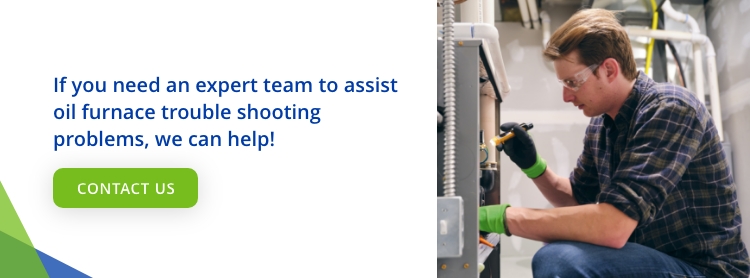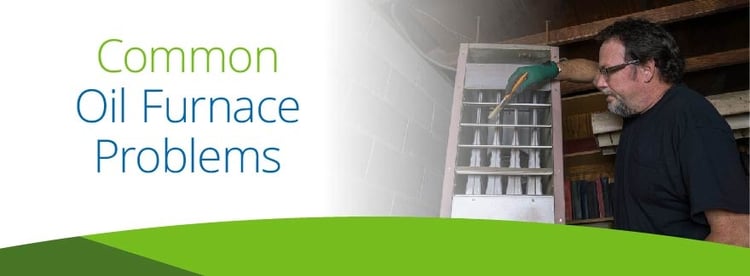
Caring for your oil tank and keeping the furnace well maintained are both essential steps if your oil heating system is going to keep you and your family warm during those long winter nights. Even with regular care, though, there are some common oil furnace problems that can occur, such as clogged filters, malfunctioning thermostats, and burner issues. It's important to address these problems with your oil heating system promptly to avoid more significant and costly repairs down the line.
- How to Identify the Causes of Unusual Sounds and Fix Them
- Possible reasons your furnace may be making strange noises
- Oil Furnace Troubleshooting: Possible solutions for oil furnace problems
Oil Furnace Problems, Causes & Solutions:
- The Furnace Suddenly Goes Off
- Excessive Smoke Is Coming From the Furnace
- The Furnace Is Burning up Far More Fuel Than Usual
- The Furnace Won’t Come on or Start up
- There’s Not Much Heat Coming From the Registers
- The Furnace Isn’t Heating Correctly
- The Blower Stays on Consistently
- The Furnace Begins Emanating Strange Odors
- The Thermostat Isn’t Functioning
In some cases, there will be a straightforward solution, and a bit of oil furnace troubleshooting might be all that is needed. However, you shouldn’t attempt to fix something if you’re not confident doing so, can’t locate the obvious problem, or suspect their might be a more complex issue with your furnace.
How to Identify the Causes of Unusual Sounds and Fix Them
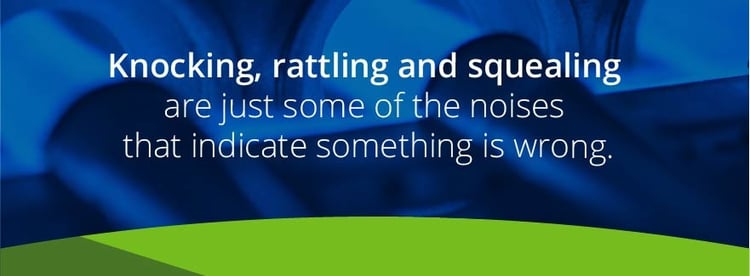
One of the most common oil furnace problems is the unusual sounds they can make when they aren’t performing as well as they could. Knocking, rattling and squealing are just some of the noises that indicate something is wrong. The type of sound your furnace is making will serve as a clue as to what might be causing the problem.
Possible reasons your furnace may be making strange noises are:
- Air in the lines
- Loose access panels
- Pilot light needs resetting
- Oil burner needs cleaning
- Blocked air
- Poor belt tension/belt worn
- Problem with the motor bearings
Oil Furnace Troubleshooting: Possible solutions for oil furnace problems:
- If you hear a knocking noise, this will often indicate that air has gotten into the lines. The solution to this is known as ‘bleeding’. It is quite a straightforward answer — but not necessarily for the beginner — and the method used can vary depending on the way your furnace is fueled. If you’re not entirely sure how to approach the task, refer to your manual or contact an expert.
- If it sounds like a clattering noise is coming from your furnace, this might mean there’s a problem with the access panels. Sometimes these panels become loose and echo around the property, making a clattering. To resolve this, inspect the panels to see if any of them have come loose and tighten up any that have.
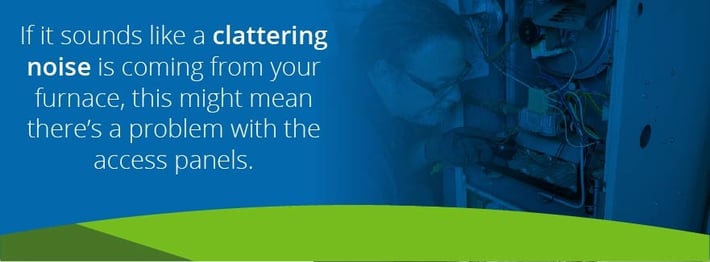
- A rumbling sound can be a sign that the pilot light has been set incorrectly or dirt might have accumulated in the gas burner. If the pilot light is set incorrectly, use the reset button to correct it. If the gas burner has become dirty, then call a technician to repair the problem.
- A whistling sound is often due to a problem with the filter. It’s usually the result of blocked air and can be caused by an accumulation of dirt and dust. Replace the filter rather than trying to clean it — the experts recommend replacing the filter at one- to three-month intervals.
- Another common noise is a screeching, squealing or other high-pitched sound. This is often an indication there is something wrong with one of the belts or blower motor. If you decide to investigate, begin by ensuring the furnace has been closed down properly. Sometimes it will be an obvious problem, such as the belt might have slipped. If the belt appears loose, change the tension. Otherwise, carry out a visual inspection of the belt and look for signs of wear or fraying. If the belt looks worn, then it might need replacing.
- If you hear a grinding noise, the furnace needs to be shut down for safety reasons. A common cause of this is a problem with the motor bearings. Don’t try and fix this problem yourself — instead, speak to an expert in oil furnace repair.
- A furnace can also make intermittent sounds like it’s turning itself on and off. If this is the case, take a look at the air filter. If it looks okay, examine the oil supply. If you can’t detect an obvious problem with the filter and you have a full tank of oil, you need to call in a professional to establish the cause.

Other Potential Furnace Issues
Of course, furnace trouble comes with other indications besides just abnormal noises. Here are some of the other problems you might encounter as well as their possible causes and solutions:
Problem: The Furnace Suddenly Goes Off
Possible causes: The thermostat might not be set correctly. Other possible causes are low fuel and blocked air filter.
Possible solutions: Check the settings on the thermostat to see if they are set as they should be. If you’re not sure of their usual settings, refer to your manual. If the thermostat is working, take a look at the fuel tank to get a real idea of the levels of fuel and rule out low fuel as a possible cause.
The air filter can also become blocked by dirt and dust, so take it out and make sure it’s clean. Air filters should be checked regularly because accumulated dirt can lead to poor efficiency. Making sure the filter is kept clean and monitoring fuel levels as a regular part of oil tank maintenance should help lower the chances of the heating going off.
You can also check the electrical supply to make sure it’s functioning. If everything is as it should be, it could indicate there is a problem with the controls. Common issues include blown fuses, exposed circuit breakers or damaged wires. However, it’s best to call the experts in to help find the actual cause.
Problem: Excessive Smoke Is Coming From the Furnace
Possible causes: A blockage in the furnace, lack of draft, warped/cracked gasket or furnace could need adjusting.
Possible solutions: Check for excessive heat coming from the combustion chamber. Excessive heat or smoke coming from the combustion chamber can indicate a blockage in your furnace, which can occur in the chimney, flue pipe, nozzle, end cones or heat exchanger.
Another possibility could be a lack of draft. This occurs when the flue pipe is too lengthy for the furnace, and while this is not a common cause, it’s a good idea to check if this is the case. A burner adjustment might also be required. If you suspect the burner needs to be adjusted, check your instruction booklet/manual for directions on how to do it.
You might also want to examine the gaskets that surround the inspection door. Sometimes they become warped or cracked and cause smoke to form. If this is the cause of the smoke, the gaskets need to be replaced.
Also, inspect the furnace for signs of clogging and pay close attention to areas such as the flue pipe, nozzle and end cones. If there is noticeable dirt, then clean the area or replace end cones or nozzles if they appear damaged.
Problem: The Furnace Is Burning up Far More Fuel Than Usual
Possible causes: Causes could include a dirty furnace, the wrong nozzle, poor ductwork, a blower motor in need of lubricating, pressure originating from the oil pump or the furnace size not being appropriate for your property.
Possible solutions: Check the condition of the furnace and clean it if you need to. Check that the nozzle is a good fit, and if necessary, replace it. If the ductwork looks worn, look for signs of leaks and use duct tape to seal any gaps. Also ensure the ductwork is insulated properly. Look at the blower motor lubrication ports — they might need oiling — and check if the pressure in the oil pump needs adjusting.
The problem could even be that the furnace is simply the wrong size for your property, or it needs adjusting. If you haven’t already, carry out a heat loss calculation to determine if the furnace is the right size. Where you can, conserve energy by shutting doors/windows and checking for signs of leaks/gaps in windows frames, which could be letting warmth escape.
Problem: The Furnace Won’t Come on or Start up
Possible causes: The furnace could need resetting. Other possible causes include a faulty connection in the thermostat, a pilot flame in need of cleaning, a switch that’s been turned off or problems with a gas valve.
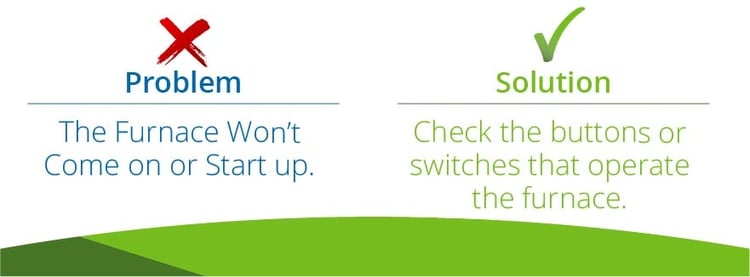
Possible solutions: Check the buttons or switches that operate the furnace — it isn’t difficult for one of them to get switched off accidentally. Next, try pressing the ‘reset’ button. However, you should only do this a maximum of two times in case it causes oil to back up and ignite. Allow up to a minute for the furnace to start.
If there is still a problem, check to see if the thermostat is functioning or if the pilot flame needs cleaning and look at the gas valve. If the pilot flame appears dirty, look at your manual for directions on the best way to clean it. If it’s not a task you’re confident with completing, call a technician.
If you’ve tried all of the above and haven’t located any issues, find the circuit breaker. Look for the switch for the furnace and check whether it’s on or if it’s slightly off center. If it’s fully on, it could be a problem with the wiring or a fuse.
If none of the above solutions are working, it could be an issue with the motor in the burner assembly. If this is the case, the motor will need to be replaced.
Problem: There’s Not Much Heat Coming From the Registers
Possible causes: An air filter could be blocked, or fan belt in the supply fan could be broken. Other causes could be problems with the ductwork.
Possible solutions: Begin by examining the filter. If it has become clogged with dirt or dust, it will need replacing. If the filter appears fine, then inspect the fan belt and the supply fan. It’s not uncommon for the fan belt to break or just need to be replaced.
The ductwork can also corrode over time. Leaky ductwork can be repaired with duct or metal tape or silicone glue — make sure the glue is suitable for high temperatures. Once the repair has been completed, it’s important to check that any combustion gases are being directed up the flue. If there is some corrosion in the ductwork, then this needs expert help.
Problem: The Furnace Isn’t Heating Correctly
Possible causes: These could be an indication of a problem with the igniter, flame sensor, continuity or draft inducer monitor.
Possible solutions: Take out the igniter and look for signs of damage or wear. If it appears damaged or worn, the igniter needs replacing. If it looks to be in good condition, check for continuity. If continuity is a problem, the igniter will need replacing as well.
Sometimes cleaning the flame sensor can be enough to restore heat. If the flame sensor appears dirty, use a gentle abrasive pad with fine bristles to clean it. If cleaning doesn’t work, then it is time to replace the sensor.
If you have ruled out a problem with the igniter and flame sensor, it could be that the draft inducer monitor needs to be replaced.
Problem: The Blower Stays on Consistently
Possible causes: The thermostat may be set incorrectly or the fan could be dirty.
Possible solutions: Check if the thermostat has been left on ‘continuous’ mode. If it has, adjust the settings. See if there are any obvious problems with the fan such as dirt or dust. The control switch could also be faulty and will need replacing.

Problem: The Furnace Begins Emanating Strange Odors
Possible causes: Unusual odors can originate from a number of causes. The most common ones are a clogged nozzle, chimney or heat exchanger. It could also be a problem with the end the cone of you might need to carry out a burner adjustment. The other cause of odors or fumes is when the combustion air becomes blocked.
Possible solutions: Begin by checking the nozzle, chimney and heat exchanger for any clogging, and then clean them if necessary. Also look for any damage that might have occurred to the heat exchanger or nozzle. If there are signs of damage, then buy a replacement. Odors can develop when the combustion becomes blocked, so conduct a combustion analysis.
Problem: There’s No Heating in a Particular Room
Possible causes: An air vent could be blocked.
Possible solutions: Examine the air vents. If you can detect any air coming from some of the vents but no other, it could be a sign of a blockage. If the cause of this isn’t easily identifiable, seek expert help.
Problem: The Thermostat Isn’t Functioning
Possible causes: There could be an issue with the power supply or a low battery signal.
Possible solutions: Take a close look at the visual display on your thermostat. If the battery supply is low or has run out, this should be indicated by a battery symbol on the thermostat screen. If you can’t see anything like that displayed on the thermostat, the cause could be a power supply problem or a faulty thermostat.
If the batteries need changing, follow the guidelines outlined in your oil furnace manual for replacing them. If the power supply is working as it should be, then it’s likely you’ll need to replace the thermostat. However, before you do that, identify the source of the problem by speaking to a technician.

Calling in the Experts Is Always an Option
While a furnace supplies a reliable form of heat, that doesn’t mean you won’t have to deal with some of the common oil furnace problems. However, with proper care, regular maintenance and a good understanding of how to fix basic issues, your furnace can provide years of reliable service.
If a problem occurs, the first step should always be to refer to the instruction booklet or to the manufacturer’s website. Remember, you should always look for the most obvious problems first, and you should never attempt a repair if you don’t have the confidence to do so or are uncertain as to the underlying cause. Before trying to fix common oil tank problems, always ensure the furnace and the circuit breaker are switched off for your safety.
If you need an expert team to assist oil furnace trouble shooting problems, we can help! Contact us today or visit our services page for more information.



